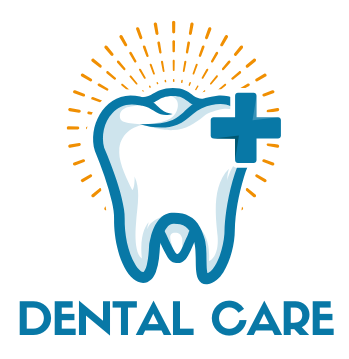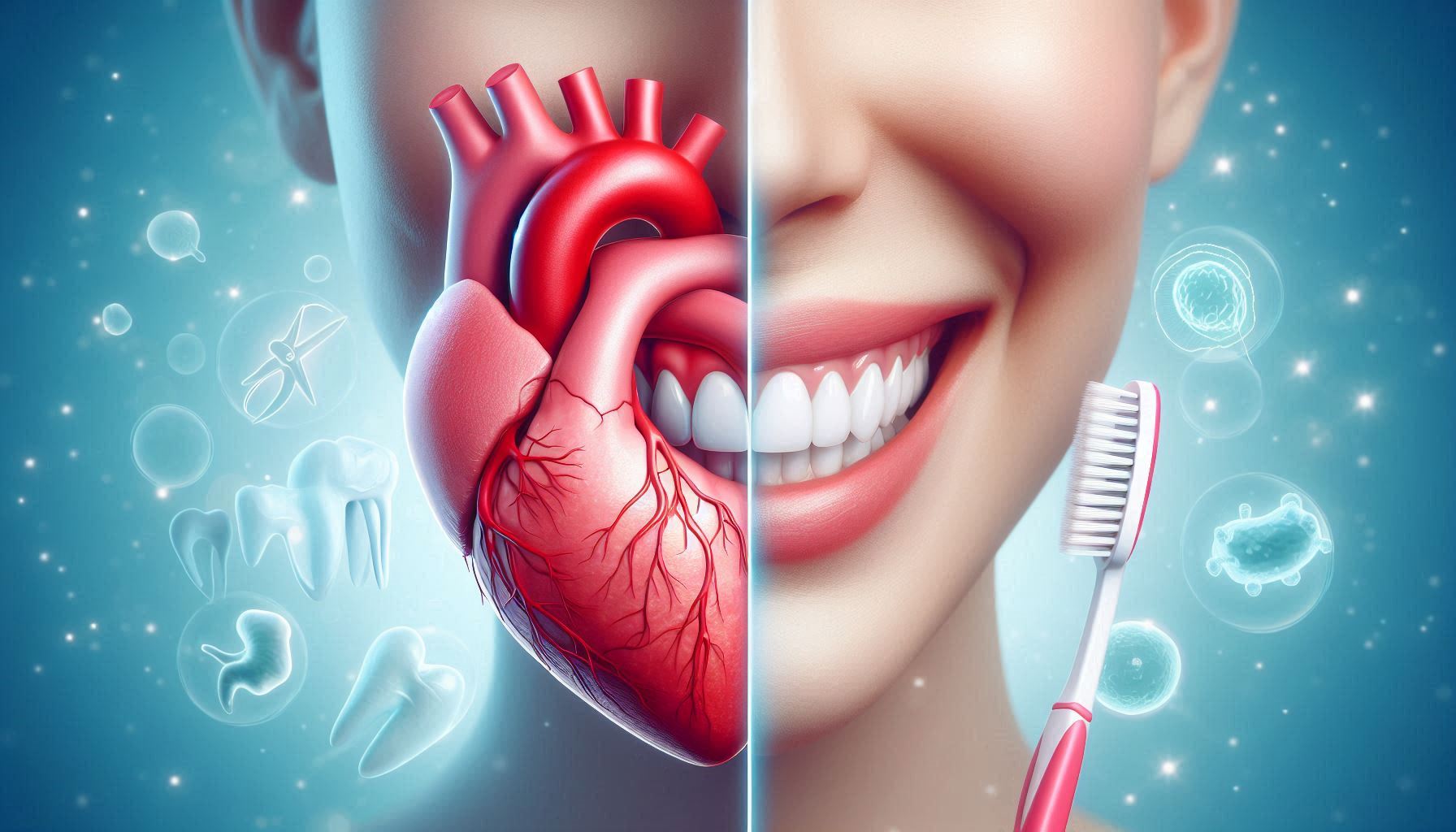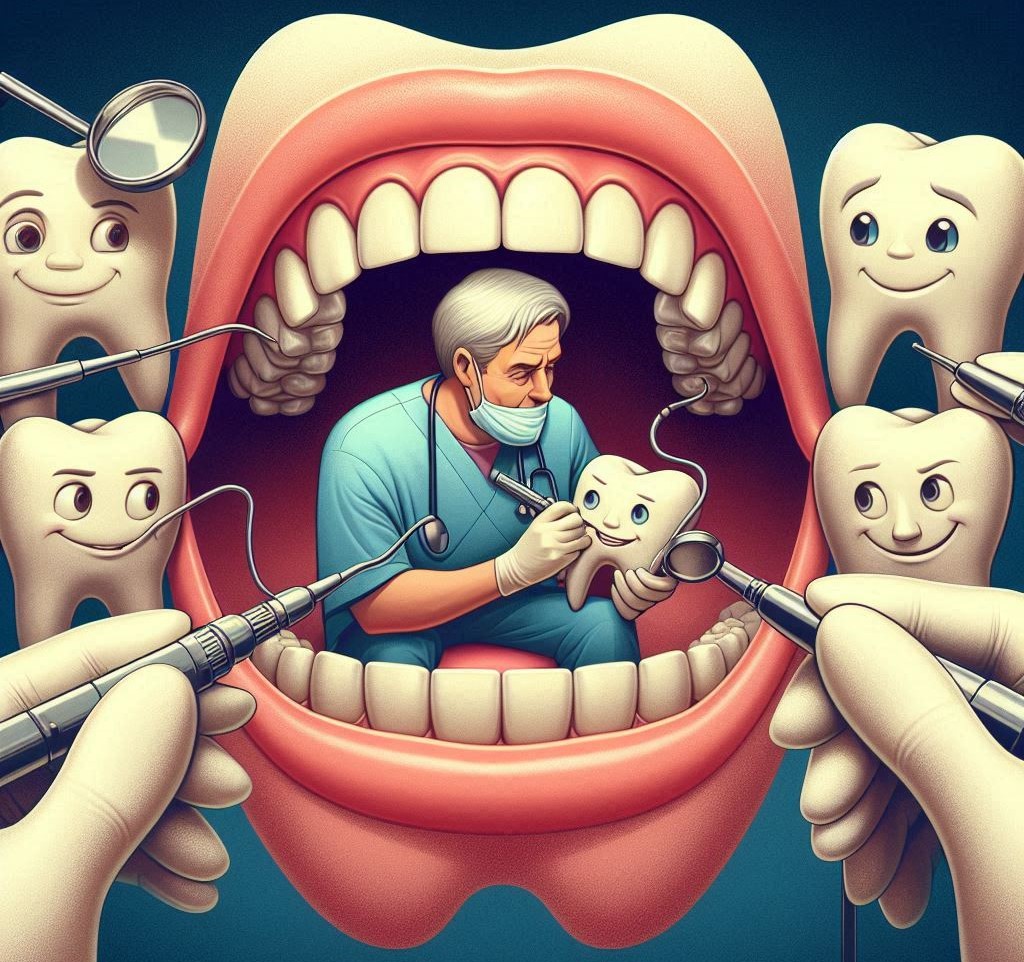The idea that oral hygiene can influence the health of your heart might seem surprising to many, but emerging research is showing a clear connection between the two. Oral health isn’t just about having a bright smile—it can also play a pivotal role in protecting your cardiovascular system. From chronic gum disease to the bacterial buildup in your mouth, the state of your oral health can directly impact your risk of developing heart disease.
In this article, we will explore how maintaining good oral hygiene isn’t just about preventing cavities or bad breath—it could very well be your first line of defense against heart disease. Through understanding the scientific connection between the mouth and heart, this article will provide actionable steps you can take to protect both your smile and your cardiovascular health.
1. Understanding the Connection Between Oral Health and Heart Disease
1.1 The Link Between Gum Disease and Heart Disease
At first glance, the relationship between gum disease (also known as periodontal disease) and heart disease might seem tenuous. However, medical professionals have been uncovering compelling evidence that supports this link. It’s believed that gum disease and heart disease share several common risk factors, such as inflammation and infection.
Gum disease is typically caused by the buildup of plaque—a sticky layer of bacteria and food particles on your teeth. If plaque isn’t removed through regular brushing and flossing, it hardens into tartar, which can cause the gums to become inflamed, a condition known as gingivitis. If gingivitis is left untreated, it can progress to periodontitis, a more severe form of gum disease that can cause the gums to pull away from the teeth, leading to tooth loss. More importantly, the bacteria responsible for periodontitis can enter your bloodstream through tiny openings in the gums. Once in the bloodstream, these bacteria can travel to other parts of the body, including the heart, where they may contribute to the development of arteriosclerosis (hardening of the arteries).
Inflammation plays a major role in both gum disease and heart disease. When your gums are infected, they release chemicals called cytokines, which contribute to the body’s inflammatory response. In the case of heart disease, these same inflammatory markers can contribute to the formation of plaque in the arteries, a condition known as atherosclerosis. Over time, this plaque can restrict blood flow to the heart, leading to increased risk of heart attacks, strokes, and other cardiovascular events.
1.2 Scientific Studies Supporting the Connection
Numerous studies have demonstrated a strong association between gum disease and cardiovascular disease. In fact, the American Heart Association (AHA) has acknowledged that there may be a link between oral health and heart health. One key study published in the Journal of the American College of Cardiology found that people with periodontal disease were at a greater risk of developing heart disease compared to those with healthy gums.
A large-scale review of studies in 2019 found that individuals with gum disease were 19% more likely to experience a heart attack, stroke, or other cardiovascular events compared to those with healthy teeth and gums. The same study concluded that the risk was even higher in those with severe gum disease, underlining the importance of preventing and treating gum infections to reduce the risk of heart disease.
1.3 The Role of Inflammation in Both Conditions
Inflammation is at the root of many chronic diseases, including both gum disease and heart disease. When the body detects an infection, it releases inflammatory molecules to help fight off the pathogens. However, when inflammation becomes chronic, it can have damaging effects on the body. This is the case with periodontitis and cardiovascular disease.
In periodontal disease, bacteria from the gums can travel into the bloodstream, triggering an immune response. This chronic inflammation can accelerate the buildup of fatty deposits, or plaque, in the arteries. Over time, the walls of the arteries become stiff and narrow, which restricts blood flow and increases the risk of blood clots. A blood clot can lead to a heart attack or stroke, both of which are life-threatening events.
Additionally, the inflammation caused by gum disease can affect other parts of the body, such as the endothelium, the thin layer of cells that line the blood vessels. Chronic inflammation weakens the endothelium, making it easier for plaque to accumulate and cause blockages.
2. The Oral Microbiome: A Gateway to Systemic Health
2.1 What Is the Oral Microbiome?
The oral microbiome refers to the community of bacteria, viruses, fungi, and other microorganisms that inhabit the mouth. These microorganisms are a natural part of the body’s ecosystem and play a crucial role in maintaining health. A healthy microbiome helps digest food, fight harmful pathogens, and protect the mucous membranes in the mouth.
However, when the balance of the microbiome is disturbed, harmful bacteria can thrive, leading to oral health problems such as gum disease, tooth decay, and bad breath. This imbalance, referred to as dysbiosis, can also have far-reaching effects on the body’s overall health, including the heart.
2.2 How Poor Oral Hygiene Disrupts the Microbiome
Poor oral hygiene allows harmful bacteria to flourish in the mouth. These bacteria produce toxic substances that can damage tissues in the gums and teeth, leading to conditions such as gingivitis and periodontitis. When these bacteria enter the bloodstream, they can travel throughout the body, triggering inflammation and contributing to systemic diseases like heart disease.
One of the most concerning aspects of oral bacteria is their ability to produce endotoxins, which can have detrimental effects on the cardiovascular system. These toxins can damage the lining of blood vessels, making it easier for fatty deposits to accumulate and form plaque. This process, known as atherogenesis, is a key step in the development of atherosclerosis, which can ultimately lead to heart attacks and strokes.
2.3 The Impact on the Heart: How Bacteria Reach the Bloodstream
When gum disease is present, bacteria in the mouth can enter the bloodstream through small openings in the gums, especially in areas where there is active infection or inflammation. These bacteria can travel to other parts of the body, including the heart, where they may contribute to the formation of plaque in the arteries. This process can increase the risk of cardiovascular diseases like heart attack, stroke, and peripheral artery disease.
Studies have found that oral bacteria such as Porphyromonas gingivalis and Fusobacterium nucleatum are particularly prevalent in people with gum disease and are also commonly found in the arterial plaque of individuals with heart disease. This connection underscores the importance of maintaining a healthy oral microbiome in preventing heart-related issues.
3. The Importance of Oral Hygiene in Preventing Heart Disease
3.1 Basic Oral Hygiene Practices for Heart Health
Brushing your teeth regularly is the most effective way to keep your mouth healthy and prevent gum disease. The American Dental Association recommends brushing your teeth at least twice a day with a fluoride toothpaste. When brushing, it’s important to clean all surfaces of your teeth, including the fronts, backs, and chewing surfaces. Brushing should take at least two minutes to ensure thorough cleaning.
In addition to brushing, flossing is essential for removing food particles and plaque from between the teeth, areas where a toothbrush may not reach. Flossing once a day helps prevent the buildup of plaque and reduces the risk of gum disease.
Another important part of oral hygiene is using mouthwash. While mouthwash cannot replace brushing and flossing, it can help reduce bacteria and freshen breath. Mouthwash containing antimicrobial agents can help reduce the overall bacterial load in the mouth, preventing gum infections.
3.2 The Role of Professional Dental Cleanings
Even with diligent at-home care, plaque and tartar can accumulate over time. This is why regular visits to the dentist are crucial. Professional cleanings help remove plaque and tartar that may have built up, reducing the risk of gum disease and improving oral health. Your dentist or hygienist can also check for early signs of gum disease or other oral health issues.
For individuals with more advanced gum disease, treatment may include scaling and root planing, a procedure in which the dentist removes plaque and tartar from beneath the gums. This treatment is essential for managing periodontitis and preventing the spread of bacteria to other parts of the body, including the heart.
3.3 Diet and Lifestyle: Supporting Oral and Heart Health Simultaneously
A heart-healthy diet is also beneficial for oral health. Foods rich in antioxidants, such as fruits and vegetables, help combat inflammation in the body, including in the gums. Foods high in fiber, like whole grains, can help remove plaque from teeth and promote overall oral health.
On the other hand, sugary and acidic foods should be limited, as they can contribute to tooth decay and gum inflammation. Reducing the consumption of tobacco and alcohol is also important for both oral and heart health, as these substances can increase the risk of gum disease and cardiovascular problems.
Regular exercise is another key factor in maintaining both oral and heart health. Physical activity helps improve circulation, reduce inflammation, and promote overall wellness.
3.4 The Role of Smoking and Alcohol Consumption
Both smoking and excessive alcohol consumption are major risk factors for gum disease and heart disease. Smoking is particularly harmful as it weakens the immune system, making it harder for the body to fight off infections in the mouth. Smokers are more likely to develop gum disease, and the inflammation in the gums can contribute to heart disease. In fact, smokers are twice as likely to suffer from gum disease compared to non-smokers.
Alcohol, when consumed in excess, can have a similar impact on oral health. It can dry out the mouth, reducing the production of saliva, which is crucial for neutralizing acids and washing away food particles and bacteria. This dry environment encourages the growth of harmful bacteria that can lead to gum disease and other oral health issues. Furthermore, excessive alcohol can increase the risk of hypertension (high blood pressure), which is a known contributor to heart disease.
By cutting down or quitting smoking and moderating alcohol intake, you can significantly improve both your oral and cardiovascular health.
4. How to Protect Your Heart and Smile—Practical Tips for Oral Hygiene
4.1 Daily Habits for Heart and Oral Health
A combination of daily oral hygiene practices and healthy lifestyle choices can go a long way in protecting both your smile and your heart. Here’s a quick guide to the essential steps:
- Brush twice a day: Use a soft-bristled toothbrush and fluoride toothpaste to brush for at least two minutes, covering all surfaces of your teeth. Make sure to brush your tongue as well to remove bacteria.
- Floss daily: Flossing is essential for reaching the areas between your teeth where plaque often builds up.
- Use mouthwash: Opt for an antimicrobial mouthwash to reduce bacteria in your mouth and freshen your breath.
- Eat a heart-healthy diet: Focus on eating nutrient-dense foods that promote both oral and heart health, such as leafy greens, nuts, and fish rich in omega-3 fatty acids.
- Stay active: Regular physical activity improves circulation, helps control blood pressure, and boosts overall health.
4.2 See Your Dentist Regularly
Regular dental check-ups are vital not only for preventing oral health issues but also for detecting early signs of gum disease that could potentially affect your heart. Make sure to schedule an appointment at least every six months for a cleaning and examination. If you have a history of heart disease or risk factors like high blood pressure or diabetes, be sure to inform your dentist, as these conditions can impact your oral health.
4.3 Control Other Risk Factors for Heart Disease
In addition to practicing good oral hygiene, managing other lifestyle factors that affect heart health is crucial. Here are a few steps you can take to further reduce your cardiovascular risk:
- Manage your stress: Chronic stress contributes to inflammation in the body, which can exacerbate both gum disease and heart disease. Find stress-reducing activities that work for you, such as meditation, deep breathing exercises, or yoga.
- Control blood pressure and cholesterol: Regular check-ups with your healthcare provider can help you keep track of your blood pressure and cholesterol levels. If they’re high, follow your doctor’s recommendations for managing them.
- Maintain a healthy weight: Being overweight or obese can increase your risk of both gum disease and heart disease. A balanced diet combined with regular exercise is key to maintaining a healthy weight.
Conclusion
The link between oral hygiene and heart health is clear—taking care of your teeth and gums is not just about preventing cavities, it’s about safeguarding your overall well-being. The bacteria and inflammation caused by gum disease can significantly contribute to the development of heart disease, making it essential to adopt a comprehensive approach to oral hygiene. By brushing, flossing, and visiting your dentist regularly, along with making heart-healthy lifestyle choices, you can protect both your smile and your heart.
The science is compelling, and the steps to take are straightforward. Don’t wait for gum disease or heart problems to develop—start today by prioritizing both your oral and cardiovascular health. In doing so, you’ll be giving yourself the gift of a longer, healthier life.
SOURCES
American Dental Association. (2020). Brushing and flossing: Tips for a healthy mouth. Journal of Dental Hygiene, 94(3), 45-50.
American Heart Association. (2019). Oral health and heart disease. Circulation, 139(10), 1905-1913.
Bissada, N. F., & Al-Zahrani, M. S. (2019). The relationship between periodontal disease and cardiovascular disease. Journal of Periodontology, 90(8), 861-869.
D’Aiuto, F., & Nibali, L. (2017). Periodontal disease and cardiovascular health: Current research and future implications. European Heart Journal, 38(13), 946-954.
Genco, R. J., & Van Dyke, T. E. (2017). Role of inflammation in periodontal disease and cardiovascular disease. Journal of Clinical Periodontology, 44(3), 47-53.
Loos, B. G., & Van Dyke, T. E. (2016). The role of inflammation in the pathogenesis of periodontal disease. Periodontology 2000, 70(1), 9-19.
Preshaw, P. M., & Taylor, J. J. (2019). How has research into periodontal disease and systemic disease progressed? British Dental Journal, 227(12), 995-1000.
Schaefer, C., & Dempster, W. (2018). Periodontal disease, bacterial infection, and their links to cardiovascular disease. Journal of Clinical Cardiovascular Science, 12(4), 230-237.
Teixeira, F. B., & Lima, S. S. (2017). Oral bacteria and cardiovascular risk: An overview of systemic effects. Journal of Oral and Maxillofacial Pathology, 21(3), 205-210.
HISTORY
Current Version
March 29, 2025
Written By:
SUMMIYAH MAHMOOD




